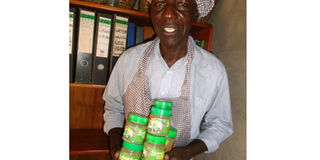Wasswa: Nakati is my moneymaker

Andrew Wasswa displays some of his products ready for sell. PHOTO BY FRED MUZAALE
What you need to know:
- Andrew Wasswa, an agro-processing agricultural officer in Kayunga District, says farmers should be encouraged to add value to produce for more cash. Wasswa, who grows Nakati on a large scale, has seen his income more than double since he started packaging dryed ones, writes Fred Muzaale.
They are widely loved and bring in valuable returns to growers, traders and processors.
Uganda is endowed with a number of vegetables which are consumed fresh.
Among the major vegetables are cabbages, bitter berries, okra, French beans, nakati (Solanum aethiopicum) and cowpeas. Vegetables are a major source of vitamins.
Many farmers grow vegetables which they sell in fresh form. However, because vegetables are highly perishable, farmers are always in a rush to sell them before they dry or wither.
Because of this, they are paid little as they cannot negotiate for good prices for their produce. However, Andrew Wasswa a vegetable farmer in Kyabazaala village Ntunda Sub-county, Mukono District has found a goldmine in drying his nakati.
This increases its shelf life; hence he is not always in a hurry to sell his produce.
Nakati is consumed by many people in central and eastern parts of Uganda.
Turning point
Wasswa says initially he could sell his fresh vegetables to traders in Nakasero and Nakawa markets but would not earn as much because he was always in a hurry to sell them.
However, he says, he tried drying it and turning it into paste and when he tasted it was still palatable. This is how he decided to start commercial drying of Nakati.
He says in 2016 he invested about Shs800,000 in buying three small solar driers, which he currently uses to dry the vegetables.
He says Nakati once planted, takes only two months to mature and a farmer can harvest leaves (for commercial purpose) for at least three months.
Drying process
Wasswa says he picks the leaves at one month before selecting the good from the bad ones.
He then washes them with clean water before boiling them in a saucepan for about 40 minutes.
When they are cooked, he removes the water and takes them to the solar drier to dry.
Drying takes two to three days when there is good sunshine.
When they are fully dry, he removes them and pounds them in a mortar because he does not want his vegetable flour to mix with maize or cassava flour when he uses a commercial public milling machine.
The nakati flour is then sieved to remove some hard particles after which it is then packed in containers of 200 grammes. He sells each container at Shs5,000.
Market
Wasswa says he sells his produce to supermarkets in Kampala, Mukono and Jinja districts.
However, he also sells to individual buyers. He adds that because he has not acquired a Q mark from UNBS, he sometimes loses big customers.
Acquiring a Q mark, he says, will enable him to export his products abroad. He says in a month he sells about 450 packs and earns about Shs3m.
After deducting all the expenses he remains with about Shs2.5m. In a plot of 100 by 100 metres he can get about Shs4.5m in two months.
How to grow nakati
Nakati grows well in fertile loam soils, however, a framer can use manure to supplement the soil fertility. The soils should be well drained and rich in Nitrogen, Potassium and Phosphorus. They should be kept weed-free for them to grow well.




